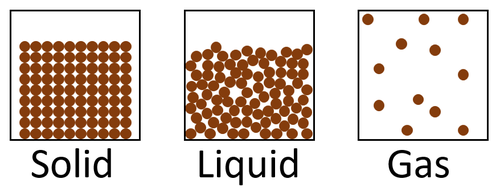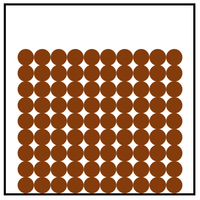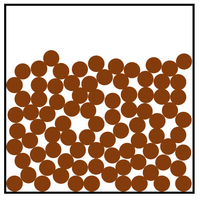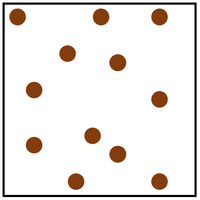Difference between revisions of "Particle Model"
(→About The Particle Model) |
|||
| Line 28: | Line 28: | ||
|- | |- | ||
|[[File:ParticleModelSolid.png|center|200px]] | |[[File:ParticleModelSolid.png|center|200px]] | ||
| − | | style="height:20px; width:200px; text-align:center;" | | + | | style="height:20px; width:200px; text-align:center;" |In a [[solid]] the [[particle]]s are in a regular arrangement and very close together. |
| − | | style="height:20px; width:200px; text-align:center;" | | + | | style="height:20px; width:200px; text-align:center;" |In a [[solid]] the [[particle]]s [[vibrate]] around fixed positions. |
|- | |- | ||
|[[File:ParticleModelLiquid.png|center|200px]] | |[[File:ParticleModelLiquid.png|center|200px]] | ||
| − | | style="height:20px; width:200px; text-align:center;" | | + | | style="height:20px; width:200px; text-align:center;" |In a [[liquid]] the [[particle]]s are in a random arrangement with small gaps between them. |
| − | | style="height:20px; width:200px; text-align:center;" | | + | | style="height:20px; width:200px; text-align:center;" |In a [[liquid]] the [[particle]]s can slide past one another. |
|- | |- | ||
|[[File:ParticleModelGas.png|center|200px]] | |[[File:ParticleModelGas.png|center|200px]] | ||
| − | | style="height:20px; width:200px; text-align:center;" | | + | | style="height:20px; width:200px; text-align:center;" |In a [[gas]] the [[particle]]s are in a random arrangement and spread far apart from one another. |
| − | | style="height:20px; width:200px; text-align:center;" | | + | | style="height:20px; width:200px; text-align:center;" |In a [[gas]] the [[particle]]s are free to move in all directions. |
|} | |} | ||
| − | |||
===Limitations of the Particle Model=== | ===Limitations of the Particle Model=== | ||
Revision as of 12:12, 19 December 2018
Contents
Key Stage 3
Meaning
The particle model is a scientific theory that explains the properties of solids, liquids and gases by suggesting that all matter is made of particles, and that those particles behave differently in solids, liquids and gases.
| A diagram showing the particle model for solids, liquids and gases. |
About The Particle Model
- The particle model explains the properties of solids, liquids and gases.
- The particle model can explain changes of state.
- Evidence of the particle model can be shown by pouring 50ml of pure water and 50ml of pure ethanol into a measuring cylinder. The solution is only 97ml because ethanol molecules are bigger than water molecules so the water molecules fit between the ethanol molecules like pouring 50ml of sand and 50ml of marbles into the same container. It will not make 100ml.
- Evidence of the particle model can be shown by observing Brownian Motion.
Key Stage 4
Meaning
The particle model is a scientific theory that explains the properties of solids, liquids and gases by suggesting that all matter is made of particles, and that those particles behave differently in solids, liquids and gases.
About The Particle Model
- The particle model describes how the particles that make a solid, liquid or gas are arranged and how they move.
| Diagram | Arrangement | Motion |
| In a solid the particles are in a regular arrangement and very close together. | In a solid the particles vibrate around fixed positions. | |
| In a liquid the particles are in a random arrangement with small gaps between them. | In a liquid the particles can slide past one another. | |
| In a gas the particles are in a random arrangement and spread far apart from one another. | In a gas the particles are free to move in all directions. |



